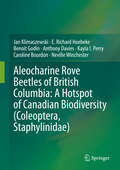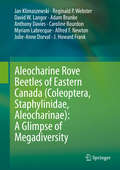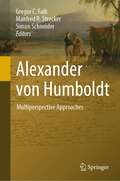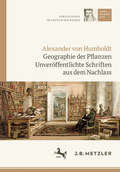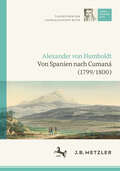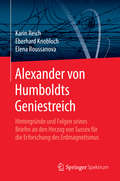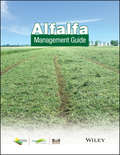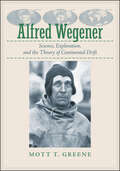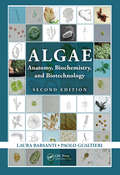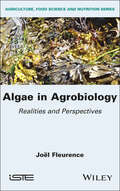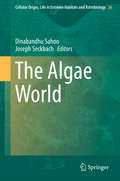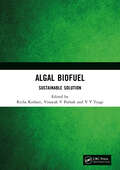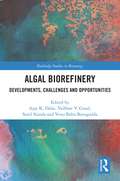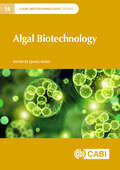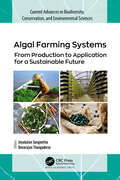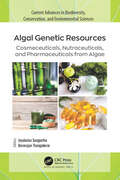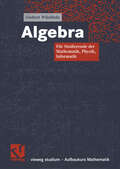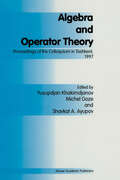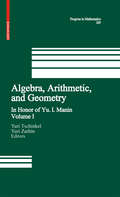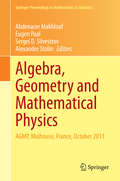- Table View
- List View
Aleocharine Rove Beetles of British Columbia: A Hotspot of Canadian Biodiversity (Coleoptera, Staphylinidae)
by Jan Klimaszewski E. Richard Hoebeke Benoit Godin Anthony Davies Kayla I. Perry Caroline Bourdon Neville WinchesterAleocharine beetles are among the most poorly known and difficult-to-identify groups of Coleoptera worldwide. This book presents the first comprehensive synopsis of aleocharine rove beetle species (Coleoptera, Staphylinidae) from British Columbia, Canada. It is important to generate a structured inventory of species in hotspots of biodiversity like British Columbia, to provide baseline biodiversity data for monitoring species responses related to climate change. It is the first book to treat and illustrate every recorded and new species. For every species, color illustrations are provided, including color habitus and genital diagnostic structures of both sexes. Two hundred and twenty-seven valid species, including 14 new species, 16 new generic records, and 36 (excluding new species) new provincial and 6 state records, in 79 genera and 14 tribes.Tribes and subtribes are arranged in phylogenetic order as it is currently recognized, and genera and subgenera are listed alphabetically within each tribe or subtribe. Species are listed alphabetically or in species groups to better reflect their relationships. Species distribution is listed by provinces and territories in Canada and states in the United States, and the geographic origin of each species is categorized as native, Holarctic, adventive or undetermined (either adventive or Holarctic). Every species is presented with a morphological diagnosis including external and genital characters of both sexes. Collection and habitat data are presented for each species, including collecting period, and collecting methods. A list of all Canadian species with their currently known distribution in North America is presented at the end of the book.
Aleocharine Rove Beetles of Eastern Canada (Coleoptera, Staphylinidae, Aleocharinae): A Glimpse of Megadiversity
by Jan Klimaszewski Reginald P. Webster David W. Langor Adam Brunke Anthony Davies Caroline Bourdon Myriam Labrecque Alfred F. Newton Julie-Anne Dorval J. Howard FrankA first comprehensive synopsis of all aleocharine rove beetle species (Coleoptera, Staphylinidae) recorded from eastern Canada, from Ontario to the Maritime Provinces inclusively, is presented. Four hundred and seven species in 96 genera, and 16 tribes are presented and discussed.Tribes and subtribes are arranged in presumably phylogenetic order as it is currently recognized. Genera and subgenera are listed alphabetically. Species are listed alphabetically or in species groups to better reflect their relationships. Species distribution is listed by abbreviated provinces and territories in Canada and abbreviated states in the United States. Geographic status is given to every species as Native, Holarctic or adventive with some species listed with undetermined status - adventive or Holarctic. Every treated species is presented with a diagnosis, including short description of body and description of the median lobe of aedeagus, spermatheca, and tergite and sternite VIII of both sexes. For each species a plate with colour habitus image and black and white images of genital structures is provided to aid with positive identification. Collection and habitat data (often new) are presented for each species, including data on macrohabitat, microhabitat, collecting period, and collecting methods.
Alexander von Humboldt: Multiperspective Approaches
by Gregor C. Falk Manfred R. Strecker Simon SchneiderThis book aims to view and to understand Alexander von Humboldt from different perspectives and in varying disciplinary contexts. His contributions addressed numerous topics in the earth but also life sciences—spanning from geo-botany, climatology, paleontology, oceanography, mineralogy, resources, and hydrogeology to links between the environmental impact of humans, erosion, and climate change. From the very beginning, he paved the way for a modern, integrated earth system science approach to decipher, characterize, and model the different forcing factors and their feedback mechanisms. It becomes obvious that Humboldt’s holistic approach is far beyond simple description and empiric data collection. As documented and analyzed in the different texts of this volume, he combines observation and analysis with emotions and subjective perceptions in a very affectionate way. However, this publication does not intend to add another encyclopedic text compilation but to observe and critically analyze this unique personality´s relevance in a modern context, particularly in discussing environmental and social key issues in the twenty-first century.
Alexander von Humboldt: Unveröffentlichte Schriften aus dem Nachlass (edition humboldt print #1)
Der Band dokumentiert ein Lebensprojekt: Für Alexander von Humboldt war die Geographie der Pflanzen empirisches Forschungsprogramm und ästhetische Anschauungswissenschaft zugleich. Seine in den amerikanischen Tropen gewonnenen biogeographischen Erkenntnisse verstand er als Grundlage einer Wissenschaft der gesamten Erde. Zahlreiche nun erstmals ediert vorliegende Manuskripte, Notizen und Briefe veranschaulichen Humboldts jahrzehntelange Arbeit an diesem Vorhaben. Sie dokumentieren Humboldts Lektüre- und Schreibpraktiken und zeigen wie er weltweit Daten sammelte sowie Forschungen und Gelehrte vernetzte. Wissenschaftshistorische Beiträge begleiten die Edition. Sie gehen Ursprüngen und Kontexten der Humboldt'schen Biogeographie nach und fragen nach weniger bekannten Vorläufern, Zeitgenossen und Kritikern.
Alexander von Humboldt-Handbuch: Leben – Werk – Wirkung | Sonderausgabe
Alexander von Humboldt ist seit dem Ausgang des 20. Jahrhunderts in den unterschiedlichsten Wissensbereichen und Wissenschaftsfeldern zu einer bedeutenden Figur im öffentlichen Diskurs geworden. Das Handbuch macht das gewaltige Oeuvre Humboldts zugänglich und beschreibt Wege und Wirkungen dieses herausragenden Forschers, Gelehrten und Schriftstellers. Ausgehend von der Einsicht in die transdisziplinäre Ausrichtung der Humboldtschen Wissenschaft rekonstruiert es Verbindungen und Wechselwirkungen der unterschiedlichen Betätigungsfelder dieses Vordenkers einer vernetzten Welt. Im Werkteil werden nicht nur die großen Buchpublikationen, sondern auch die unselbständigen Schriften, die umfangreiche Korrespondenz und der Nachlass behandelt. Humboldts wissenschaftliche Aktivitäten werden aus unterschiedlichen Blickwinkeln, von der Wissenschaftsgeschichte und den Naturwissenschaften bis hin zu Geschichts- und Sprachwissenschaft beleuchtet. Auch seine Tätigkeitsfelder in den Bereichen Politik und Diplomatie oder Kunst und Ästhetik werden diskutiert, schließlich die wichtigsten seiner Beziehungen zu Wissenschaftlern und Literaten.
Alexander von Humboldt: Tagebücher der Amerikanischen Reise: Von Spanien nach Cumaná (edition humboldt print #1)
Der erste Tagebuchband der amerikanischen Reise Alexander von Humboldts gibt Einblicke in die Überfahrt von Europa nach Amerika, den Aufenthalt auf Teneriffa und in das Leben und Arbeiten in Cumaná. In seinem Tagebuch beschreibt Humboldt, wie Klima und Vegetation die Kulturgeschichte des Menschen prägen, und bringt seinen Abscheu gegenüber der Sklaverei zum Ausdruck. Sein Interesse gilt ebenso der tropischen Pflanzen- und Tierwelt wie der Lebensweise der indigenen Bevölkerung. Im Herbst 1799 wird er zudem Zeuge einer Sonnenfinsternis, eines Erdbebens und eines beeindruckenden Meteorschauers. Besonders zu faszinieren vermag sein beständiges Ringen um eine Optimierung der Messmethoden. Sein Ziel ist die Kartierung eines noch weitgehend unerschlossenen Kontinents, und er weiß, dass die enormen Anstrengungen, die er und sein Forschungspartner Aimé Bonpland auf sich nehmen, nur dann gerechtfertigt wären, wenn die erhobenen Daten valide sind. – Der durchgängig kommentierte Text ist in neun Kapitel unterteilt, denen jeweils kleine Einführungen vorangestellt sind.
Alexander von Humboldts Geniestreich: Hintergründe und Folgen seines Briefes an den Herzog von Sussex für die Erforschung des Erdmagnetismus
by Karin Reich Eberhard Knobloch Elena RoussanovaDer Brief, den Alexander von Humboldt am 23. April 1836 an Augustus Frederick, den Herzog von Sussex – damals Präsident der Royal Society of London – richtete, ist wahrscheinlich der wichtigste und der folgenreichste Brief, den der berühmte deutsche Forschungsreisende in seinem Leben verfasst hat. Dieser These gehen die Autoren der vorliegenden Studie nach, zumal die Quellen, Hintergründe und Folgen dieses epochemachenden Briefes bislang nicht im Detail untersucht waren.Humboldt ging es vor allem um den Ausbau und die Erweiterung der erdmagnetischen Forschungen im britischen Empire, was die globale Erforschung dieses rätselhaften Naturphänomens fördern sollte. Er hat sein Schreiben genau zum richtigen Zeitpunkt verfasst: Der Brief löste eine Lawine von Forschungsaktivitäten aus. Von Humboldts Initiative profitierte nicht allein Großbritannien, sondern auch Russland, die USA und – was bislang kaum wahrgenommen bzw. herausgestellt wurde – Göttingen, das zum Zentrum der erdmagnetischen Forschungen weltweit avancierte. Die Studie zeigt deutlich, dass Humboldts Brief nur deshalb so überaus erfolgreich sein konnte, weil er sich auf die von Carl Friedrich Gauß und Wilhelm Weber in Göttingen erzielten Forschungen zu stützen vermochte: So war Humboldts Erfolg auch ein Verdienst von Gauß und Weber. Der Brief Humboldts wird in der vorliegenden Monographie erstmals nach der Originalvorlage ediert und auch in deutscher Übersetzung vorgestellt. Ferner werden weitere relevante Dokumente sowohl in Originalsprache als auch in deutscher Übersetzung veröffentlicht. Die Darstellung wird von informativem, historischem Bildmaterial ergänzt. Der Band wendet sich an ein Fach- wie auch an ein wissenschaftshistorisch interessiertes Publikum.
Alfalfa Management Guide (ASA, CSSA, and SSSA Books #152)
by Dan Undersander Mark Renz Craig Sheaffer Glen Shewmaker Mark SulcLearn how to achieve top yields to maximize profits. This 2011 edition offers the latest information and strategies for alfalfa establishment, production, and harvest. Includes many color photos and charts.
Alfred Wegener: Science, Exploration, and the Theory of Continental Drift
by Mott T. GreeneAlfred Wegener aimed to create a revolution in science which would rank with those of Nicolaus Copernicus and Charles Darwin. After completing his doctoral studies in astronomy at the University of Berlin, Wegener found himself drawn not to observatory science but to rugged fieldwork, which allowed him to cross into a variety of disciplines. The author of the theory of continental drift;¢;‚¬;€?the direct ancestor of the modern theory of plate tectonics and one of the key scientific concepts of the past century;¢;‚¬;€?Wegener also made major contributions to geology, geophysics, astronomy, geodesy, atmospheric physics, meteorology, and glaciology. Remarkably, he completed this pathbreaking work while grappling variously with financial difficulty, war, economic depression, scientific isolation, illness, and injury. He ultimately died of overexertion on a journey to probe the Greenland icecap and calculate its rate of drift. This landmark biography;¢;‚¬;€?the only complete account of the scientist;€™s fascinating life and work;¢;‚¬;€?is the culmination of more than twenty years of intensive research. In Alfred Wegener, Mott T. Greene places Wegener;€™s upbringing and theoretical advances in earth science in the context of his brilliantly eclectic career, bringing Wegener to life by analyzing his published scientific work, delving into all of his surviving letters and journals, and tracing both his passionate commitment to science and his thrilling experiences as a polar explorer, a military officer during World War I, and a world-record;€“setting balloonist. In the course of writing this book, Greene traveled to every place that Alfred Wegener lived and worked;¢;‚¬;€?to Berlin, rural Brandenburg, Marburg, Hamburg, and Heidelberg in Germany; to Innsbruck and Graz in Austria; and onto the Greenland icecap. He also pored over archives in Copenhagen, Munich, Marburg, Graz, and Bremerhaven, where the majority of Wegener;€™s surviving papers are found. Written with great immediacy and descriptive power, Alfred Wegener is a powerful portrait of the scientist who pioneered the modern concept of unified Earth science. The book should be of interest not only to earth scientists, students of polar travel and exploration, and historians but to all readers who are fascinated by the great minds of science.
Algae: Anatomy, Biochemistry, and Biotechnology, Second Edition
by Laura Barsanti Paolo GualtieriA single-source reference on the biology of algae, Algae: Anatomy, Biochemistry, and Biotechnology, Second Edition examines the most important taxa and structures for freshwater, marine, and terrestrial forms of algae. Its comprehensive coverage goes from algae's historical role through its taxonomy and ecology to its natural product possibilities.
Algae in Agrobiology: Realities and Perspectives
by Joel FleurenceAlgae, macroalgae and microalgae can be valuable biological resources in a new, more environmentally friendly form of agriculture known as agrobiology. Indeed, the biological properties associated with algae are frequently relevant for agricultural and zootechnical purposes. It is this aspect that is behind the current popularity of algae in the development of new agricultural practices that are related to plant and animal production, which are referred to as agrobiology. Algae in Agrobiology offers a current and forward-looking account of algae use: in agriculture and in the sector of land and marine animal production, as algal extracts and molecules in the form of fertilizers or biostimulants for crops with agronomic interest, and as algal compounds in the area of plant and animal health. This book is based on advances in biochemical and agronomic research in order to explain the conventional practices associated with the use of algae in agriculture and livestock breeding. These advances make it possible to establish possible uses for marine algal resources in the agriculture of the future.
Algae in Agrobiology: Realities and Perspectives
by Joel FleurenceAlgae, macroalgae and microalgae can be valuable biological resources in a new, more environmentally friendly form of agriculture known as agrobiology. Indeed, the biological properties associated with algae are frequently relevant for agricultural and zootechnical purposes. It is this aspect that is behind the current popularity of algae in the development of new agricultural practices that are related to plant and animal production, which are referred to as agrobiology. Algae in Agrobiology offers a current and forward-looking account of algae use: in agriculture and in the sector of land and marine animal production, as algal extracts and molecules in the form of fertilizers or biostimulants for crops with agronomic interest, and as algal compounds in the area of plant and animal health. This book is based on advances in biochemical and agronomic research in order to explain the conventional practices associated with the use of algae in agriculture and livestock breeding. These advances make it possible to establish possible uses for marine algal resources in the agriculture of the future.
The Algae World (Cellular Origin, Life in Extreme Habitats and Astrobiology #26)
by Dinabandhu Sahoo Joseph SeckbachAlgal World has been carefully written and edited with an interdisciplinary appeal and aims to bring all aspects of Algae together in one volume. The 22 chapters are divided into two different parts which have been authored by eminent researchers from across the world. The first part, Biology of Algae, contains 10 chapters dealing with the general characteristics, classification and description of different groups such as Blue Green Algae, Green Algae, Brown Algae, Red Algae, Diatoms, Xanthophyceae, Dinophyceae, etc. In , it has two important chapters covering Algae in Extreme Environments and Life Histories and Growth Forms in Green Algae. The second part, Applied Phycology, contains 12 chapters dealing with the more applied aspects ranging from Algal Biotechnology, Biofuel, Phycoremediation, Bioactive Compounds, Biofertilizer, Fatty Acids, Harmful Algal Blooms, Industrial Applications of Seaweeds, Nanotechnology, Phylogenomics and Algal culture Techniques, etc.
Algal Biofuel: Sustainable Solution
by Richa Kothari Vinayak V. Pathak V. V. TyagiAlgal Biofuel: Sustainable Solution primarily focuses on the different aspects of bioenergy production using algal biomass as microalgae are considered the optimum feedstock for bioenergy production. The major aim is to thoroughly review the available bioenergy options, challenges in bioenergy production, availability of bioenergy feedstock, and biomass to bioenergy conversion process. This book also highlights the feasibility of lignocellulosic biomass, crop residues, and non-edible oil seeds for generation of different bioenergy products. It will be helpful for researchers and other stakeholders working in the area of bioenergy production for development of innovative concepts in emerging areas of bioenergy. Print edition not for sale in South Asia (India, Sri Lanka, Nepal, Bangladesh, Pakistan and Bhutan).
Algal Biofuel: Sustainable Solution
by Richa Kothari Vinayak V. Pathak V. V. TyagiAlgal Biofuel: Sustainable Solution primarily focuses on the different aspects of bioenergy production using algal biomass as microalgae are considered the optimum feedstock for bioenergy production. The major aim is to thoroughly review the available bioenergy options, challenges in bioenergy production, availability of bioenergy feedstock, and biomass to bioenergy conversion process. This book also highlights the feasibility of lignocellulosic biomass, crop residues, and non-edible oil seeds for generation of different bioenergy products. It will be helpful for researchers and other stakeholders working in the area of bioenergy production for development of innovative concepts in emerging areas of bioenergy. Print edition not for sale in South Asia (India, Sri Lanka, Nepal, Bangladesh, Pakistan and Bhutan).
Algal Biorefinery: Developments, Challenges and Opportunities (Routledge Studies in Bioenergy)
by Ajay K. Dalai Vaibhav V. Goud Sonil Nanda Venu Babu BorugaddaThis book enables readers to understand the theoretical aspects, key steps and scientific techniques with a detailed mechanism to produce biofuels from algae. Each chapter provides the latest developments and recent advancements starting from algal cultivation techniques to the production of value-added green fuels, chemicals and products with wide applications. The volume brings together a broad range of international and interdisciplinary experts, including chemical and biological engineers, biotechnologists, process engineers, environmentalists, pharmacists and nutritionists, to one platform to explore the beneficial aspects and challenges for an algal-based biorefinery. Chapters address cutting edge issues surrounding algal cultivation, including genetic modification of algal strains, designing and optimization of photo-bioreactors and open pond systems, algal oil extraction techniques and algal-derived fuel products (biodiesel, bio-gasoline, jet-fuels and bio-oil). Finally, the book considers the potential environmental impacts for establishing a sustainable algal bio-refinery through lifecycle analysis, techno-economic assessment and supply chain management. This book will be an important resource for students, academics and professionals interested in algal cultivation, biofuels and agricultural engineering, and renewable energy and sustainable development more broadly.
Algal Biorefinery: Developments, Challenges and Opportunities (Routledge Studies in Bioenergy)
by Ajay K. Dalai Vaibhav V. Goud Sonil Nanda Venu Babu BorugaddaThis book enables readers to understand the theoretical aspects, key steps and scientific techniques with a detailed mechanism to produce biofuels from algae. Each chapter provides the latest developments and recent advancements starting from algal cultivation techniques to the production of value-added green fuels, chemicals and products with wide applications. The volume brings together a broad range of international and interdisciplinary experts, including chemical and biological engineers, biotechnologists, process engineers, environmentalists, pharmacists and nutritionists, to one platform to explore the beneficial aspects and challenges for an algal-based biorefinery. Chapters address cutting edge issues surrounding algal cultivation, including genetic modification of algal strains, designing and optimization of photo-bioreactors and open pond systems, algal oil extraction techniques and algal-derived fuel products (biodiesel, bio-gasoline, jet-fuels and bio-oil). Finally, the book considers the potential environmental impacts for establishing a sustainable algal bio-refinery through lifecycle analysis, techno-economic assessment and supply chain management. This book will be an important resource for students, academics and professionals interested in algal cultivation, biofuels and agricultural engineering, and renewable energy and sustainable development more broadly.
Algal Biotechnology (CABI Biotechnology Series)
by Yahui Bo Gao Chen Lei Chen Zhenfan Chen Zixi Chen Pengfei Cheng Feng Ge Jiameng Guo Sanjay Gupta Xiahui Hao Qingfang He Fan Hu Hanhua Hu Krishna Kumar Jaiswal Hu Jin Vinod Kumar Anping Lei Anna I. Kurbatova Chao Li Yanhua Li Hanzhi Lin Lu-Ning Liu Qiong Liu Yandu Lu Anastasios Melis Yufang Pan Vishal Rajput Roger Ruan Shengzhou Shan Kaitlin Simmons Xiaotong Song Xinyu Song Adamu Yunusa Ugya Mikhail S. Vlaskin Chun Wang Jiangxin Wang Jin Wang Xiaojun Yan Wenxiu Yin Weiwen Zhang Xiangxiang Zhang Xu Zhang Yu-Zhong Zhang Long-Sheng Zhao Quanyu Zhao Chengxu Zhou Yali Zhu Zhu Zhen Tian Jing Cao XupengAlgae are sunlight-driven cell factories, and can efficiently absorb CO2 and convert light energy to chemical energy such as lipid, starch and other carbohydrates and release O2. Algal feedstock is a promising resource for bioproduct production, given its high photosynthetic efficiency for producing biomass compared to conventional crops. Microalgae can be used for flue-gas and wastewater bioremediation. This book highlights recent breakthroughs in the multidisciplinary areas of algal biotechnology and the chapters feature recent developments from cyanobacteria to eukaryotic algae, from theoretical biology to applied biology. It also includes the latest advancements in algal-based synthetic biology, including metabolic engineering, artificial biological system construction and green chemicals production. With contributions by leading authorities in algal biotechnology research, it is a valuable resource for graduate students and researchers in the field, and those involved in the study of photosynthesis and green-cell factories.
Algal Farming Systems: From Production to Application for a Sustainable Future (Current Advances in Biodiversity, Conservation, and Environmental Sciences)
by Jeyabalan Sangeetha Devarajan ThangaduraiThe farming and cultivation of algae can provide sustainable solutions for issues like food security-related problems, costly health-related products, sustainable fuels, and more. However, the use of algae is currently restricted to high-value, low-volume markets, mainly due to the high investment and production costs involved. In recent years, algaculture for food and fuel purposes has begun a transition from R&D and pilot-scale operations to commercial-scale systems. This new book presents the latest technological innovations in algae production, market status, and prospects for algal applications.The book provides an informative overview of different perspectives on the commercial production of algae-based food, health, and high-value cosmeceutical products, providing an institutional framework to support and promote the development and commercialization of algal farming. The book discusses phycotechnology and highlights the current trends and future scope of algal technology. It also presents new information on algal culture conditions and cultivation strategies, including a look at geographic position and local climate as key factors in the implementation of microalgae-based processes. Algal production, marketing strategies, and their commercialization are discussed, as are the industrial applications of algae, focusing mainly on nutraceutical, pharmaceutical, and cosmeceutical applications of microalgae and macroalgae.
Algal Farming Systems: From Production to Application for a Sustainable Future (Current Advances in Biodiversity, Conservation, and Environmental Sciences)
The farming and cultivation of algae can provide sustainable solutions for issues like food security-related problems, costly health-related products, sustainable fuels, and more. However, the use of algae is currently restricted to high-value, low-volume markets, mainly due to the high investment and production costs involved. In recent years, algaculture for food and fuel purposes has begun a transition from R&D and pilot-scale operations to commercial-scale systems. This new book presents the latest technological innovations in algae production, market status, and prospects for algal applications.The book provides an informative overview of different perspectives on the commercial production of algae-based food, health, and high-value cosmeceutical products, providing an institutional framework to support and promote the development and commercialization of algal farming. The book discusses phycotechnology and highlights the current trends and future scope of algal technology. It also presents new information on algal culture conditions and cultivation strategies, including a look at geographic position and local climate as key factors in the implementation of microalgae-based processes. Algal production, marketing strategies, and their commercialization are discussed, as are the industrial applications of algae, focusing mainly on nutraceutical, pharmaceutical, and cosmeceutical applications of microalgae and macroalgae.
Algal Genetic Resources: Cosmeceuticals, Nutraceuticals, and Pharmaceuticals from Algae (Current Advances in Biodiversity, Conservation, and Environmental Sciences)
by Jeyabalan Sangeetha Devarajan ThangaduraiThis book focuses on the current and potential applications of microalgae and cyanobacteria in pharmaceuticals, nutraceuticals, and cosmeceuticals. The book deals with the very recent and advanced techniques and technologies in algal cultivation and extraction for its application. The chapters discuss the biological importance, properties, and uses of algal metabolites and microalgae-based compounds in drug development, in food nutrition enhancement, and in the development of cosmetics with medicinal properties. The chapter authors cover a range of diverse topics on algal biological resources, such as: algae as a nutraceutical and functional food ingredient the extraction of food bioactive compounds from microalgae spirulina-derived nutraceuticals and their applications in the food industry anticancer compounds from freshwater microalgae cosmetic applications of microalgal and cyanobacterial pigments and more This unique book, Algal Genetic Resources: Cosmeceuticals, Nutraceuticals, and Pharmaceuticals from Algae, will enlighten readers on the vast usefulness of microalgae and cyanobacteria as an important resource for the cosmeceutical, pharmaceutical and nutraceutical industries for their broad biotechnological potential industrial applications. The volume will be a valuable reference for scientists and researchers in these areas as well as for advanced students and faculty in ecology, phycology, botany, agriculture, biotechnology, microbiology, environmental biotechnology, plant science, and life sciences.
Algebra: Für Studierende der Mathematik, Physik, Informatik (vieweg studium; Aufbaukurs Mathematik #91)
by Gisbert WüstholzDieses Buch ist eine moderne Einführung in die Algebra, kompakt geschrieben und mit einem systematischen Aufbau. Der Text kann für eine ein- bis zweisemestrige Vorlesung benutzt werden und deckt alle Themen ab, die für eine breite Algebra Ausbildung notwendig sind (Ringtheorie, Körpertheorie) mit den klassischen Fragen (Quadratur des Kreises, Auflösung durch Radikale, Konstruktionen mit Zirkel und Lineal) bis zur Darstellungstheorie von endlichen Gruppen und einer Einführung in Algebren und Moduln. "Den Autor vorzustellen, hieße Eulen nach Athen zu tragen. Nicht unvermutet präsentiert er auf knappstem Raum eine Fülle von interessantem Material. [...] Ein sehr empfehlenswertes Buch, das vor allem Vortragende ansprechen kann." Monatshefte für Mathematik, 02/2005
Algebra and Operator Theory: Proceedings of the Colloquium in Tashkent, 1997
by Y. Khakimdjanov M. Goze Sh. AyupovThis volume presents the lectures given during the second French-Uzbek Colloquium on Algebra and Operator Theory which took place in Tashkent in 1997, at the Mathematical Institute of the Uzbekistan Academy of Sciences. Among the algebraic topics discussed here are deformation of Lie algebras, cohomology theory, the algebraic variety of the laws of Lie algebras, Euler equations on Lie algebras, Leibniz algebras, and real K-theory. Some contributions have a geometrical aspect, such as supermanifolds. The papers on operator theory deal with the study of certain types of operator algebras. This volume also contains a detailed introduction to the theory of quantum groups. Audience: This book is intended for graduate students specialising in algebra, differential geometry, operator theory, and theoretical physics, and for researchers in mathematics and theoretical physics.
Algebra, Arithmetic, and Geometry: Volume I: In Honor of Yu. I. Manin (Progress in Mathematics #269)
by Yuri Tschinkel Yuri ZarhinAlgebra, Arithmetic, and Geometry: In Honor of Yu. I. Manin consists of invited expository and research articles on new developments arising from Manin’s outstanding contributions to mathematics.
Algebra, Geometry and Mathematical Physics: AGMP, Mulhouse, France, October 2011 (Springer Proceedings in Mathematics & Statistics #85)
by Abdenacer Makhlouf Eugen Paal Sergei D. Silvestrov Alexander StolinThis book collects the proceedings of the Algebra, Geometry and Mathematical Physics Conference, held at the University of Haute Alsace, France, October 2011. Organized in the four areas of algebra, geometry, dynamical symmetries and conservation laws and mathematical physics and applications, the book covers deformation theory and quantization; Hom-algebras and n-ary algebraic structures; Hopf algebra, integrable systems and related math structures; jet theory and Weil bundles; Lie theory and applications; non-commutative and Lie algebra and more.The papers explore the interplay between research in contemporary mathematics and physics concerned with generalizations of the main structures of Lie theory aimed at quantization and discrete and non-commutative extensions of differential calculus and geometry, non-associative structures, actions of groups and semi-groups, non-commutative dynamics, non-commutative geometry and applications in physics and beyond.The book benefits a broad audience of researchers and advanced students.
